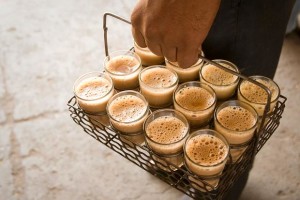 Masala Chai? For those unaware, this simply means spiced tea in the Hindi language. The masala part is often missed out as it s easier to say one word (chai) than two. Whenever a guest arrives in Indian households, they are asked if they would like “chai-paani?” which means if they would like some tea or water. Furthermore, the term “cutting chai” is used to describe a glass of tea that is served by the street chai vendors of India. So in the West, when you’re asking for a chai tea you’re really asking for a tea tea!
Masala Chai? For those unaware, this simply means spiced tea in the Hindi language. The masala part is often missed out as it s easier to say one word (chai) than two. Whenever a guest arrives in Indian households, they are asked if they would like “chai-paani?” which means if they would like some tea or water. Furthermore, the term “cutting chai” is used to describe a glass of tea that is served by the street chai vendors of India. So in the West, when you’re asking for a chai tea you’re really asking for a tea tea!
A brief history of chai (tea) in India
Tea had been growing wild in India since the 12th century. The locals of that time utilized the plant, however to the rest of the population tea was a myth until the mid 19th-century when the British East India company imported some tea from China and planted it in India for commercial tea production in the 1820s. This tea was planted in the Darjeeling hills and this is where the Darjeeling tea variety is produced. Around the same time, the explorer Major Robert Bruce discovered wild tea plants growing in the Assam region of India (which coincidentally happens to produce the world famous Assam tea variety). Tea gained popularity in the north of India, while coffee was more liked in the south. Tea did face some stiff competition from nationalist such as Mahatma Gandhi who did not like the fact that Indian labourers were being exploited on the British plantations. The reduction of the price of tea in the 1960s made tea more affordable for the poorer people of India which gave rise to the chai street stalls in India.
Chai in India today
Over two thirds of the tea produced in India is used by the Indians themselves! There are many different types of masala chai tea. Chai is etched into the fabric of Indian society and nothing says this more than the hosts of India, the chaiwala. The suffix “wala” refers to someone to does a specific job, so in this case a chaiwala is someone whose job it is to make chai. The name is given to all the street chai vendors who have stalls that can virtually be found on every street corner in India! These vendors dish out masala chai to all those who want it and are constantly busy because of India’s love for chai. Traditionally, the masala chai is served in clay cups that can be glazed or unglazed. However as mentioned above, it is more common now to use a glass which is referred to as “cutting chai”. Chaiwalas also deliver tea to nearby businesses when called. It is common practice for business owners to order some tea for customers while they shop. This generally tends to happen if there is a wait involved such as when clothes or footwear shopping.
Furthermore, chai is popular in films. in Danny Boyle’s film Slumdog Millionaire the main character is a chaiwala. Also in Bollywood films it is very rare not to find at least one scene in which chai is referenced. Even more so, Bollywood actors are used for chai endorsements and the type of chai they drink is followed with keen interest.
So to recap all of that, masala chai means spiced tea in Hindi/ Urdu!
